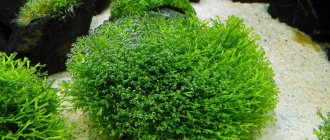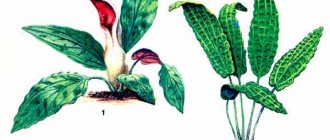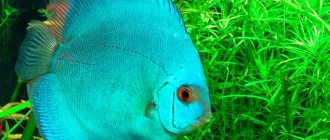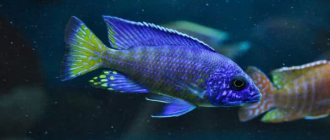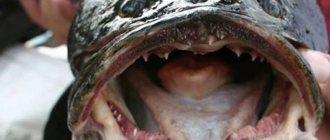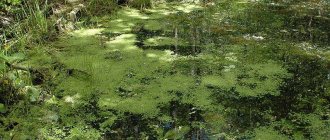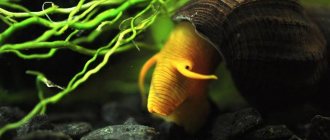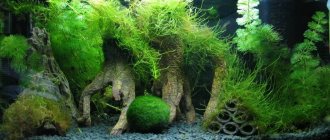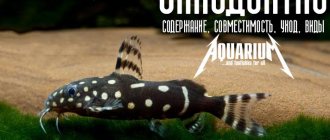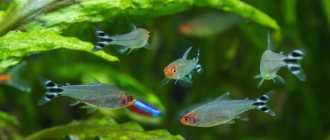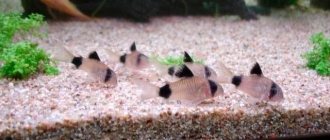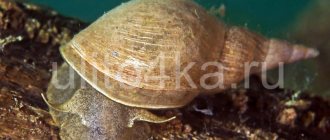Echinodorus is a perennial marsh plant that has gained popularity in the aquarium hobby due to its decorative value and large number of species. Thus, among the representatives of Echinodorus you can find plants 5 cm and one meter high. They have different colors, structures and leaf shapes. This variety allows you to choose a plant for any aquarium.
Kinds
There are 47 species of Echinodorus used in aquarium landscaping. They include natural and hybrid forms.
The most common ones are listed in the table.
| View | Description |
| Amazonian | The most common of all types. In aquariums it grows up to 35-40 cm. Its leaves are bright green, narrow and long, forming a dense rosette. It grows evenly throughout the year. |
| Echinodorus Blechera | Grows in central South America. Grows up to 40-50 cm in height. It has narrow, pointed leaves that form a dense bush. |
| Horizontal | This species is very popular among aquarists. It has an unusual appearance - the heart-shaped leaves are located horizontally to the ground, at an angle to the petiole. They grow up to 20-25 cm. |
| Mottled | The low-growing species grows up to 20 cm. It has short petioles, with heart-shaped, pointed leaves covered with brown specks. Forms a dense rosette. |
| small-flowered | It grows up to 35-40 cm. It looks like a dense bush, with wide, elongated leaves and a short petiole. The leaf blade is dark green with brown veins. |
| Gentle | This species is also called dwarf. It has bright green elongated leaves without petioles, which form dense rosettes. It reaches a height of 7-10 cm. |
| Osiris | In aquariums they grow up to 40-50 cm. Forms dense bushes with leaves of golden brown, crimson or brown-red color in young plants, which then become olive to dark green in color. |
| Cordifolia | It can reach 80 cm. It has elongated petioles, with bright green ovoid leaves, with pointed or rounded edges. |
| Narrow-leaved | This species has short petioles, with long ribbon-shaped leaves with a pointed tip of light green color. In aquariums it reaches up to 60 cm in length. |
| Argentinian | The largest and most whimsical of all representatives. Grows up to 100 cm in length. It has very dense leaves of a dark green color. |
| Uruguayan | The maximum size of this species is 40 cm. It has very dense rosettes, which can contain up to 100 leaves of a narrow elliptical shape with wavy edges. Leaf color varies from light green to dark burgundy. |
| Aflame | Selective variety, difficult to maintain. It has beautiful dark burgundy leaves on both sides, with wavy edges. In an aquarium it grows up to 30 cm. |
| Vesuvius | Another artificially obtained variety. It has narrow ribbon-like leaves twisted into a spiral. The height of the bush does not exceed 15 cm. |
| Maghrebi | A hybrid variety, grows up to 35 cm. It has elongated leaves with wavy edges. Color varies from light pink to brown shades. |
| Ocelot | Brought out by selection. The bush grows up to 20 cm, has large, dense leaves with dark red spots. |
| Hildebrant | Hybrid of two Echinodorus. Small bushes 15-20 cm, with red-burgundy leaves in young plants, and green in adults. |
| Rose | Hybrid. The bush grows up to 10-20 cm in height and 20-40 cm in width. The leaves are narrow, elliptical in shape, light or olive green in color, sometimes with red splashes. |
| Ruby | Tall breeding form. Reaches 60 cm in height. It has narrow long leaves, red-brown or olive-green depending on age. |
| Dark Beauty | A small hybrid, approximately 20 cm. Young leaves have a bright burgundy color, which darkens with age. |
| Python | A selection form, can reach a height of 50 cm. Quite hardy. It has long leaves, green with a brown tint. Young leaves can also be light cherry in color |
| "St. Elmo's Fire" | Obtained by crossing Echinodorus. The maximum size of the bush is 25 cm. It has beautiful oval leaves of bright red color with small inclusions. |
Echinodorus Blechera
Botanical properties
Echinodorus (from Latin Echinodorus) is a perennial marsh herbaceous plant with leaves of various shapes, sizes and colors. A typical species characteristic is the presence or absence of a transparent (and sometimes darker than the base) color pattern consisting of lines or dots. Being a rather unpretentious plant in terms of water hardness, pH level and temperature, it is tolerant of changes, which is why it is easy to grow, and some varieties even feel comfortable on land.
The sizes of Echinodorus vary from a few centimeters to one and a half meters in height, depending on the species and conditions of detention. During the flowering period, it forms a long peduncle with a small inflorescence at the top.
Maintenance and care
Echinodorus are hardy aquarium plants that can adapt to different conditions and rarely get sick. Due to the wide variety of species, plants are conventionally divided into simple and more demanding to care for.
Simple
This group includes the most common species - American, rose, horizontal, osiris, speckled, Uruguayan echinodorus, etc. These species are not particularly demanding, but several conditions should be met:
- Water: temperature 18-26 °C, hardness 5-15, acidity 6.5-7.5.
- Intense lighting over 0.7 W/l, with 11-14 hour daylight hours.
- You will need a nutrient substrate (fine gravel or sand, fraction 3-7mm).
- Filtration and aeration in the aquarium are required.
- Siphon the soil and change a quarter of the water weekly.
Speckled Echinodorus
Demanding
This category includes Argentine, tender, heart-leaved echinodorus and their selection forms. For these species, an additional supply of carbon dioxide up to a level of 20 mg/l, and a full range of macro- and microelements are fundamentally important.
Small plants need intense lighting, without which they degrade, become smaller and may die. Large species, on the contrary, need to be limited in lighting so that they do not become a surface form. The length of daylight hours for them should not exceed 10 hours. All other conditions are similar to other types.
Cordifolia Echinodorus
Compatibility
When starting to plant Echinodorus in an artificial reservoir, you should take into account its compatibility with other types of flora. Thus, when selecting according to the requirements of lighting, temperature and other important indicators of the habitat, you should definitely take into account the size of the final form in order to avoid further shading and/or displacement of the crop.
It is not particularly recommended to plant it next to Cryptocoryne, but Sagittaria will make a pretty good neighbor.
Echinodorus is an excellent choice for landscaping aquariums, including cichlids, as well as paludariums, terrariums and even greenhouses, becoming not only an indispensable decorative element, but also a complete shelter and source of oxygen for both fish and amphibians and reptiles.
How to plant
Small-sized echinodorus can be planted in the center or along the edges of the aquarium, large representatives - at the back wall of the tank or in separate pots.
Rules for planting in the ground:
- First, inspect the plant, carefully remove damaged leaves and roots. Then it needs to be disinfected for 20 minutes in a weak solution of potassium permanganate or rinsed in a solution of hydrogen peroxide (1 tsp/1 l).
- Dig a small hole in the soil, place a ball of clay for better growth, carefully place the root and cover with soil.
Rules for planting in pots:
- You will need a small pot 7-8 cm high, in which you need to drill holes.
- Place a mixture of garden soil and fine gravel on the bottom, place a ball of clay, then a plant and carefully cover with fine gravel or sand.
Echilodorus grows quickly and has a powerful root system, and when planted in pots, it will need to be transplanted into larger containers every 6-12 months.
Echinodorus parviflora
The benefits of Echinodorus for the aquarium
Echinjdorus Ozelot is an artificially created plant. The “parents” of the ocelot were Echinodorus Schluteri Leopard and Barthii, crossed in Hans Barth’s nursery in 1995. Since then, this species has become the most popular aquarium plant.
The demand for the ocelot is explained by the benefits it brings to the inhabitants of the underwater world. Thanks to Echinodorus:
- water hardness decreases;
- the amount of harmful substances in the container is reduced;
- the fish have additional shelters and spawning sites.
The ocelot is unpretentious, able to adapt to various environmental conditions and is suitable for any pet that is not prone to eating vegetation.
Reproduction
Aquarium echinodorus reproduce in several ways:
- Seeds. Some selective and hybrid species reproduce exclusively this way. You can purchase seeds or wait for your plant to bloom. They form on flowers located above the surface of the water. Next, the seeds need to be sown in a separate bowl with sand covered with water at a temperature of 28°C. As soon as 3 leaves appear, you can transplant the plant into the aquarium.
- Vegetatively. Simple plant species reproduce in this way. They form many daughter shoots, from which new bushes develop. Find the outermost shoot, carefully cut it from the mother plant and transplant it into another aquarium.
- Dividing the roots. Remove the plant, remove spoiled leaves, wash well and trim the roots. Separate the roots so that there are 4-6 leaves on each side and cut in one motion using a utility knife or blade. There is no need to process the sections with anything.
Echinodorus osiris
Distinctive features of plants
All species of Echinodorus do not have a stem. The leaves grow from the rhizome, on which thickenings are formed followed by the development of buds. In the future, but only under good conditions, new plants can begin to develop from the buds. Thus, vegetative propagation of plants occurs.
The leaves of Echinodorus are dense, and their shape can be different: oval, spear-shaped, round, heart-shaped, linear. The color of the leaves, as well as their shape, can also vary, ranging from soft green to red.
Under good conditions in the aquarium, Echinodorus can bloom. A peduncle is thrown into the water, at the end of which an inflorescence is visible. Branches and leaves form on the peduncle, and over time a root appears. New plants can be separated from the mother bush and planted in a new location.
Under natural conditions, Echinodorus can reproduce by seeds. This is incredibly difficult to do in an aquarium.
Fertilizers
Echinodorus receives nutrition equally from both soil and water, and is very fond of feeding:
- once a month, apply liquid mineral fertilizers at the rate of 10-15 ml per 100 liters of water;
- Apply clay balls under the roots of the plant every three to six months.
Echinodorus Python
Echinodorus is a wonderful aquarium plant. Among the variety of species, there are those suitable for beginners and those that experienced aquarists can handle. The most common types are easy to care for and rarely get sick. If all maintenance recommendations are followed, Echinodorus will delight you with its healthy appearance, bright color and rapid growth.
Additional recommendations
In order for Echinodorus to fully develop and not be susceptible to a number of typical diseases, experienced aquarists advise paying attention to the following recommendations:
- Periodic replacement and filtration of water in the aquarium.
- Siphon the soil to avoid rotting of the root system.
- Periodic treatment of roots with birch charcoal.
- Additional lighting for 10 hours a day.
- Additional supply of oxygen and carbon dioxide.
- Fertilizing the soil with basal and root baits.
Following these simple tips will help protect the aquarium plant from putrefactive processes and various diseases, prolong its life and maintain its spectacular appearance.
To prevent the appearance of calcium deposits on the leaf plates, it is recommended to add snails or ancistrus to the aquarium.
Echinodorus coexist well with other aquarium plants that are approximately the same size as them. More spreading growths will shade the Echinodorus, which can negatively affect its growth and external characteristics. If you plant a plant with smaller algae, then the opposite situation is possible, especially if we are talking about light-loving crops.
Supreme Landscaper
Among aquarium plants, the supreme gardener deserves special attention. After all, their leaves are distinguished by a bright emerald hue. The leaves are distinguished by increased density and the presence of veins.
The Supreme Landscaper is easy to keep. To fill the bottom, a substrate with nutrients and useful components is used.
For the normal development of the plant, the supreme gardener requires a voluminous tank, which has a large area. The lid of the container must be supplemented with lighting equipment. The duration of daylight hours is 10–12 hours.
The supreme gardener rarely produces the arrows that are necessary for normal propagation.
The height of the supreme gardener plant reaches 25–30 cm. It grows in the form of a bush, so the central part of the aquarium is allocated for its placement.
Description
In nature, this plant was found in South America, but today it can be found in almost any country. In its natural environment it resembles wild Echinodorus parviflora.
It belongs to the category of amphibians - plants that get along well both on land and under water.
Echinodorus tropicalis is quite modest in size. If there is insufficient lighting, its height can be only 5 cm, but the required amount of light will allow it to grow up to 30 and even 40 cm. The leaves have a rich dark green color. Old leaves become hard and dark, and the network of veins forms an unusual pattern. The leaf shape is rounded, the texture is decorative. Together they form a rosette and actually grow from the base.
